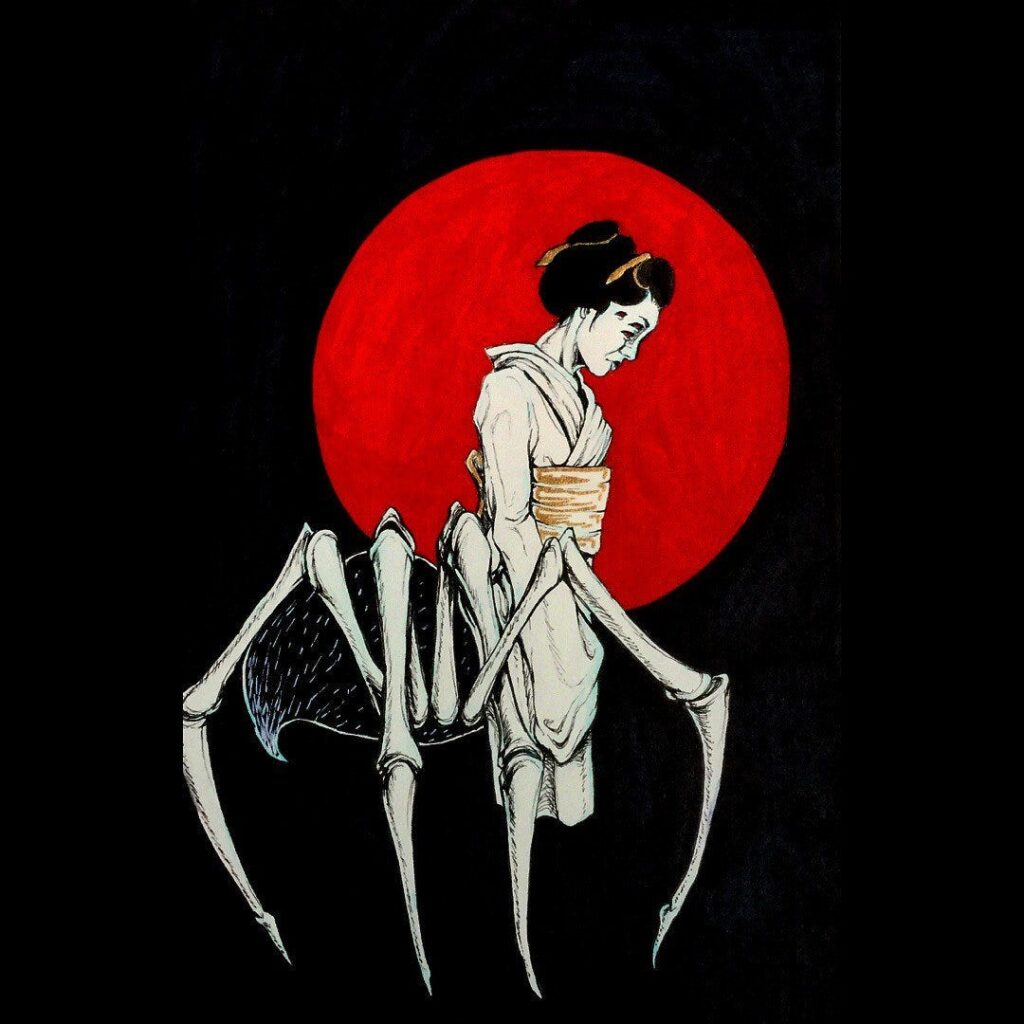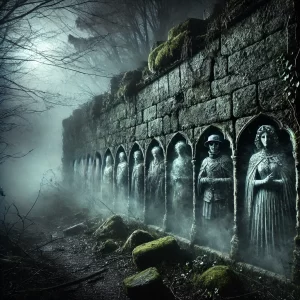Unveiling the Enigmatic Jorogumo: Japan’s Alluring Yet Deadly Spider Yokai
Welcome to the mysterious world of Japanese folklore, where mythical creatures roam the shadows, luring unsuspecting souls into their web of enchantment and treachery. Among the myriad yokai that populate these age-old legends, none are as beguiling and terrifying as the Jorogumo. Also known as the “Binding Bride” or “Entangling Bride,” this enigmatic creature is both captivating and deadly, capable of weaving a seductive illusion that conceals its monstrous true nature.
In this blog post, we embark on a journey into the heart of the Jorogumo legend. Unraveling its ancient origins and exploring the captivating tales that have endured for centuries, we delve deep into the realms of Japanese folklore to understand the eerie allure of this shape-shifting spider yokai. From its haunting presence in abandoned locales to the tragic encounters of mortals ensnared in its fatal embrace, the Jorogumo’s story is as intricate as its mesmerizing webs.
Join us as we traverse the dark forests and forgotten corners of Japan, where unsuspecting travelers must beware the beguiling beauty that conceals a chilling secret. Are you prepared to face the Jorogumo’s seduction and survive its deadly embrace? Brace yourself as we immerse ourselves in the captivating lore of the Jorogumo, unearthing the mysteries behind this alluring yet malevolent creature that has enthralled generations with its haunting tales.
What is the origin of the Jorogumo?
The origin of the Jorogumo is deeply rooted in Japanese folklore and mythology. The creature’s legend has evolved over centuries, and its origins can be traced back to various cultural and historical influences.
One key aspect of the Jorogumo’s origin lies in Japan’s fascination with spiders. In ancient times, spiders were often associated with mystical powers and supernatural abilities due to their exceptional silk-weaving skills and their sometimes-dangerous venom. They were seen as creatures of both cunning and creativity, and this led to the development of spider-themed myths and folklore.
Another contributing factor to the Jorogumo’s legend is the traditional belief in shape-shifting creatures known as yokai. Yokai are supernatural beings in Japanese folklore, often depicted as spirits, monsters, or ghosts with magical powers. Shape-shifting yokai were especially intriguing because they could transform from one form to another, usually to deceive or harm humans. The Jorogumo embodies this concept of a creature that can take on an alluring human form, using it to ensnare and trap its prey.
Additionally, the legend of the Jorogumo was likely influenced by cultural cautionary tales. Japan has a rich tradition of folklore designed to teach moral lessons and warn against certain behaviors or actions. The Jorogumo’s tale serves as a cautionary warning about the dangers of being seduced by beauty without knowing the true nature of what lies beneath the surface.
Over time, as these different elements intertwined, the legend of the Jorogumo took shape and became a well-known part of Japanese folklore. The creature’s association with spiders, its shape-shifting abilities, and its captivating yet deadly nature all contributed to making the Jorogumo a memorable and enduring figure in Japanese mythology.
It’s important to remember that folklore and legends often evolve through oral storytelling, and as such, there may be variations and regional differences in the Jorogumo’s origin story. Nonetheless, the Jorogumo’s status as a captivating and fearsome creature has persisted, captivating the imaginations of generations across Japan and beyond.

Who does the Jorogumo Tend to Attack?
The Jorōgumo primarily targets men as its victims. In Japanese folklore, this shape-shifting spider yokai is often depicted as a female entity with the ability to transform into a beautiful woman. In her human form, she seeks to seduce and deceive men, luring them into her web and trapping them for her own malevolent purposes.
The Jorōgumo’s choice to target men may stem from cultural and traditional gender roles prevalent in Japanese society during the time when the legends of the yokai were developing. In many folklore stories, women were often portrayed as enchantresses or seductresses who could lead men astray with their beauty and allure. The Jorōgumo embodies this archetype, using her alluring human form to entice men into her clutches, where she reveals her true monstrous nature and ensnares them.
It’s worth noting that the specific motivations and reasons for the Jorōgumo’s actions may vary in different retellings of the legend. Some stories portray her as seeking revenge for past wrongs, while others depict her as a malevolent creature preying on human weaknesses. Regardless of the variation, the central theme remains consistent – the Jorōgumo preys on men who fall victim to her seductive disguise, making her a symbol of cautionary tales about the dangers of being lured by appearances and the importance of discernment.
Are People Really Afraid of Jorogumo?
In modern times, the fear of the Jorogumo is not as widespread or prevalent as it may have been in ancient Japan. Today, the Jorogumo is primarily viewed as a creature of folklore and mythology rather than a real threat. The tales of the Jorogumo and other yokai are considered part of Japan’s cultural heritage and are often appreciated as fascinating stories that showcase the creativity and imagination of traditional Japanese storytelling.
While the fear of the Jorogumo may have diminished over time, these mythical creatures still hold a significant place in Japanese culture. They continue to be popular subjects in literature, manga, anime, video games, and other forms of media, contributing to the preservation and adaptation of their legends for contemporary audiences.
In the modern context, people are more likely to view the Jorogumo and other yokai as intriguing and entertaining elements of Japanese folklore, rather than genuine objects of fear. However, just like with any cultural myth or legend, individual reactions may vary, and some people may still find the stories of the Jorogumo eerie or unsettling.
It’s essential to remember that beliefs and attitudes toward mythical creatures like the Jorogumo can vary across different cultures and communities. In Japan, the appreciation and interpretation of yokai legends often reflect a blend of historical superstitions, cultural values, and artistic expression.

Jorogumo in Popular Culture
The Jorogumo and other yokai from Japanese folklore have made appearances in various forms of popular culture, showcasing their enduring influence on modern media. Here are some examples of the Jorogumo in popular culture:
- Anime and Manga: Yokai-themed anime and manga often feature the Jorogumo as one of the creatures encountered by characters. For example, in the anime “Nurarihyon no Mago“, the Jorogumo appears as a formidable antagonist. Additionally, “GeGeGe no Kitaro,” a long-running anime and manga series centered around yokai, occasionally features the Jorogumo in its episodes.
- Video Games: The Jorogumo and other yokai have made appearances in video games as both enemies and characters. Games like “Nioh” and “Nioh 2” draw heavily from Japanese folklore, featuring the Jorogumo as one of the many formidable yokai the player encounters. In “Okami,” a popular action-adventure game, the Jorogumo is depicted as a boss battle.
- Movies and TV Shows: Japanese horror movies and TV shows often draw inspiration from yokai legends, and the Jorogumo has been featured in various horror-themed productions. For example, “Jigokuhen: Jorogumo” is a Japanese horror film based on the Jorogumo legend.
- Books and Novels: Several authors, both Japanese and non-Japanese, have incorporated the Jorogumo and other yokai into their novels and fantasy stories. These depictions may vary, ranging from traditional folklore-based narratives to modern reinterpretations.
- Art and Illustrations: Artists and illustrators, particularly those who specialize in yokai-themed works, often create striking images of the Jorogumo. These artworks can be found in various online galleries, books, and exhibitions dedicated to yokai and Japanese folklore.
- Role-Playing Games: In tabletop role-playing games like “Dungeons & Dragons” and “Pathfinder,” yokai, including the Jorogumo, are often included as creatures that players can encounter or even play as characters.
These examples demonstrate how the Jorogumo and other yokai continue to capture the imagination of creators and audiences alike, cementing their place in contemporary popular culture while also preserving and honoring Japan’s rich folklore traditions.
What to do if you come Face to Face with a Jorogumo
If, by some improbable chance, you were to come face to face with a Jorogumo (which, I must emphasize, is a mythical creature and not a real entity), it would be crucial to remember that your safety and well-being are not at risk in reality. However, in the context of folklore and storytelling, encounters with yokai like the Jorogumo often involve elements of danger and cautionary lessons. Here’s what you might do in the context of a mythical encounter:
- Stay Calm: In folklore, Jorogumo is known for her ability to deceive and entice her victims. Staying calm and composed is essential to avoid falling into her trap.
- Trust Your Instincts: If something seems amiss or too good to be true, trust your instincts and be wary of sudden or suspicious changes in the environment.
- Avoid Isolated Places: In legends, the Jorogumo is said to reside in remote and abandoned areas. To minimize risk in folklore, it’s best to avoid isolated places or unfamiliar environments.
- Don’t Accept Gifts or Invitations: The Jorogumo may attempt to lure you with gifts or invitations. In folklore, it’s often advised not to accept anything from unfamiliar or potentially dangerous entities.
- Seek Help: If you find yourself in a perilous situation in folklore or fiction, seeking help from a knowledgeable person or a wise elder can be beneficial.
- Learn About Yokai: Understanding the folklore and legends surrounding yokai can give you insights into their characteristics and potential behaviors.
Remember, these tips are relevant only in the context of folklore and storytelling. In reality, there are no Jorogumo or other shape-shifting yokai to be concerned about. Enjoy the mythical tales for their entertainment value and the rich cultural heritage they represent.
In conclusion, the Jorogumo, an enchanting yet deadly spider yokai from Japanese folklore, continues to captivate audiences in various forms of popular culture. Its origins lie in Japan’s fascination with spiders, shape-shifting yokai, and cautionary tales, making it a symbol of the dangers of deceptive allure and the importance of discernment. While fear of the Jorogumo has waned in modern times, its enduring presence in literature, anime, video games, and art showcases its lasting impact on Japanese culture. Although mythical encounters with the Jorogumo are nothing more than captivating tales, they remind us of the power of imagination and storytelling in preserving cultural heritage and passing down moral lessons from generation to generation. Let us continue to appreciate the timeless allure of the Jorogumo and other mythical creatures as guardians of our collective folklore.


















































Leave a Reply